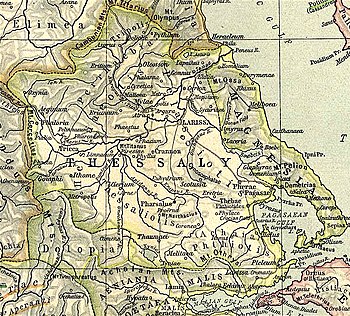Pelinna


| |
| O: Horseman striking at fallen Hoplite with javelin | R: Warrior holding shield
ΠΕΛΙNNA_ION |
| silver coin from Pelinna struck 400-344 BC. | |
39°34′33″N 21°55′35″E / 39.575731°N 21.926477°E Pelinna (
The city had a celebrated temple of Zeus Pelinnaeus. Pelinna was situated between
It seems to have been a place of some importance even in the time of Pindar. Alexander the Great passed through the town in his rapid march from Illyria to Boeotia.[6] It did not revolt from the Macedonians together with the other Thessalians after the death of Alexander the Great.[12] In the war between Antiochus III the Great and the Romans, 191 BCE, Pelinna was occupied by the Athamanians, but was soon afterwards recovered by the Romans.[13] The location of Pelinna is at Palaiogardíki (Petroporos),[14][15] where there are considerable remains of the ancient town. William Martin Leake, describing the situation in the 19th century, stated that "the city occupied the face of a rocky height, together with a large quadrangular space at the foot of it on the south. The southern wall is more than half a mile in length, and the whole circumference near three miles."[16] Joseph Hilarius Eckhel writes that the coins of this town bore the inscription Πεληναῖον.[17] The nearby modern town of Pelinnaioi reflects the ancient name.
References
- ^ Stephanus of Byzantium. Ethnica. Vol. s.v.
- ^ Pliny. Naturalis Historia. Vol. 4.8.15.
- Ab urbe condita Libri[History of Rome]. Vol. 36.10.
- ^ so in Scylax and Pindar, P. 10.4.
- ^ a b Strabo. Geographica. Vol. ix. p.437. Page numbers refer to those of Isaac Casaubon's edition.
- ^ a b Arrian, Anabasis, 1.7.
- ^ Dictionary of Greek and Roman Geography (1854), Pelinna
- ISBN 0-19-814099-1.
- ^ S. Miller, Two Groups of Thessalian Gold Page 25 (Berkeley: University of California Press, 1979)
- ISBN 90-04-16371-9
- ^ For the Greek text of one of the lamellae, see PHI Greek Inscriptions 37:497A
- ^ Diodorus Siculus. Bibliotheca historica (Historical Library). Vol. 18.11.
- Ab urbe condita Libri[History of Rome]. Vol. 36.10, 14.
- ISBN 978-0-691-03169-9.
- ^ Lund University. Digital Atlas of the Roman Empire.
- ^ Leake, Northern Greece, vol. iv. p. 288.
- ^ Eckhel, Doctrina numorum veterum, vol. ii. p. 146.
![]() This article incorporates text from a publication now in the public domain: Smith, William, ed. (1854–1857). "Pelinna". Dictionary of Greek and Roman Geography. London: John Murray.
This article incorporates text from a publication now in the public domain: Smith, William, ed. (1854–1857). "Pelinna". Dictionary of Greek and Roman Geography. London: John Murray.
External links
